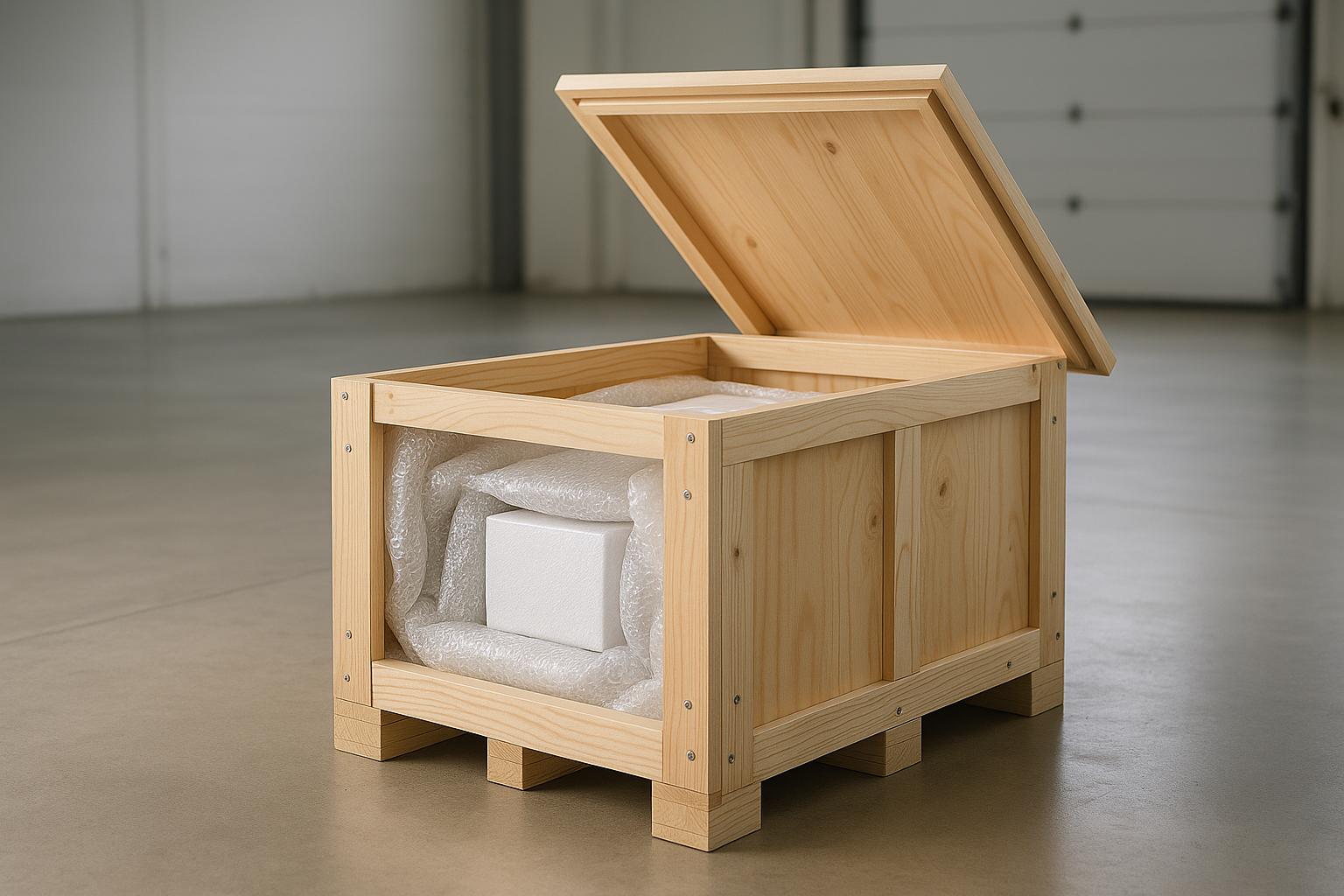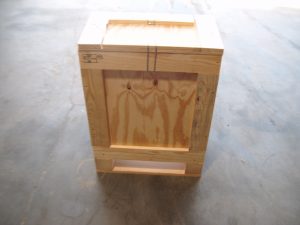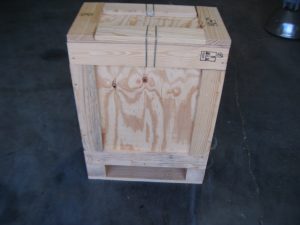Choosing the right wooden crate for shipping is crucial to protecting your goods, meeting regulations, and avoiding costly mistakes. Here’s how to get it right:
- Protection: Wooden crates shield items from impacts, vibrations, and weather. Use padding, foam inserts, or reinforced designs for fragile goods.
- Measurements: Accurately measure your item’s size and weight, allowing extra space for cushioning.
- Destination Needs: Factor in climate, transit time, and handling conditions. Moisture-resistant treatments or insulation may be necessary.
- Material Choice: Solid wood is strong but heavy, while plywood is lighter and cost-effective. Ensure compliance with ISPM 15 for international shipments.
- Construction: Reinforced joints, skid runners, and custom interiors reduce damage risk and improve durability.
- Regulations: Follow ISPM 15 standards to avoid delays or fines. Use certified treated wood and proper compliance stamps.
- Moisture Protection: Add vapor barriers, desiccants, or protective coatings to safeguard shipments in humid or ocean environments.
How We Build Our Shipping Crates | RealCraft
How to Assess Your Shipping Requirements
Before choosing a wooden crate, it’s crucial to clearly understand what you’re shipping and where it’s headed. Properly assessing your shipping needs can help you avoid costly mistakes during transit.
Measuring Item Size and Weight
Start by measuring the length, width, and height of your item in inches. Be sure to account for any protruding parts and add about ½ inch of clearance for cushioning. Use a digital scale to record the weight in pounds. Always round up your final measurements and double-check for accuracy. Once you have these dimensions, you can evaluate how much protection your shipment will require.
Determining Protection Requirements for Fragile Items
Understanding your item’s vulnerabilities is key to determining the right level of protection. Shipping risks vary – your product might face impacts, vibrations, moisture, or even electrostatic discharge. For example, glass items need padding to guard against impacts and vibrations, while electronics might require anti-static materials and controlled humidity levels.
For items that are especially fragile, consider double boxing. This involves wrapping the item securely, placing it in a smaller cushioned box, and then placing that box inside a larger crate with additional padding. A quick test: gently shake the crate. If you hear movement, add more padding.
Different industries also have unique packaging needs. For instance, semiconductors require packaging that is ESD-safe and resistant to humidity, while glass products may need dividers and corner protectors to prevent contact between items. Proper weight distribution is equally important – place heavier items at the bottom and ensure the weight is evenly spread to avoid shifting during transit. Once you’ve addressed protection, it’s time to consider the destination and handling conditions.
Planning for Destination and Handling Conditions
Using your measurements and protection plans as a foundation, design your crate to handle the specific challenges of its destination. Think about factors like climate and handling practices at the receiving location. Features like forklift cutouts, built-in handles, enhanced insulation, and moisture-resistant treatments can help protect your shipment from condensation, temperature changes, and rough handling.
Transit time is another key consideration. Longer shipping durations mean prolonged exposure to temperature and humidity variations. For sensitive items like electronics or beverages, maintaining stable conditions is critical. In such cases, opt for crates with superior insulation and moisture-resistant finishes.
Prepare for the worst when it comes to handling. If your crate might be exposed to outdoor conditions during loading or storage, ensure the wood is treated to resist moisture and pests. Secure the crate with straps or tie-downs to keep it stable in shipping containers or on pallets. For destinations with extreme weather, consider applying weather-resistant coatings to shield your shipment from sun, rain, or snow.
How to Select Crate Materials and Construction
Once you’ve evaluated your shipping requirements, the next step is deciding on the right materials and construction features for your wooden crate. These choices will directly influence the cost, weight, and level of protection your crate provides.
Solid Wood vs. Plywood Options
Solid wood is known for its strength and ability to handle heavy loads, but it comes with added weight, which can drive up shipping costs. For international shipments, solid wood typically needs to be treated to comply with ISPM-15 standards.
On the other hand, plywood offers a better strength-to-weight ratio, making it lighter and more cost-efficient for shipping. It’s also easier to assemble but may not match solid wood’s durability for extremely heavy loads.
When deciding between these materials, think about the value of the contents you’re shipping. The crate’s quality should match the importance of what’s inside. Additionally, while solid wood requires treatment for international compliance, some engineered materials are exempt from ISPM-15, which can simplify the process for global shipments. Beyond the material itself, the construction features you choose will play a key role in ensuring your crate performs well during transit.
Key Construction Features for Durability
The way a crate is built significantly impacts its durability during shipping. Reinforced corners and supports are essential for absorbing shocks and distributing weight evenly, which boosts the crate’s overall strength.
Using engineered fastenings like 4-inch screw assemblies, reinforced joints, and interlocking panels can provide the structural stability needed to withstand vibrations, impacts, and rough handling. Heavy-duty skid runners are another useful feature, as they improve load stability and make it safer to move the crate with forklifts or pallet jacks.
Interior customization can also make a big difference. Features like shelving, foam inserts, or cradles help secure items and reduce movement that could cause damage. The choice between open-slatted and fully enclosed designs depends on your needs: open-slatted crates allow for ventilation, while fully enclosed ones offer complete protection from external elements. Wire-bound crates are another option, offering added durability and better support for stacking.
Keep in mind, there are no universal standards for determining a crate’s load capacity. Factors like the grade of lumber, thickness of plywood, strength of fasteners, and the overall quality of construction all play a role in how much weight a crate can handle. To ensure your crate meets your shipping demands, it’s a good idea to work with experienced manufacturers who can perform accurate load calculations.
sbb-itb-1c2a65d
Meeting Shipping Standards and Regulations
Once you’ve chosen the right materials and design for your crate, the next step is ensuring it complies with all necessary shipping regulations. Meeting these standards is essential for avoiding delays, unexpected costs, or even the rejection of your shipment.
ISPM 15 Certification Requirements
ISPM 15 is an international standard created by the International Plant Protection Convention (IPPC) to regulate wood materials thicker than 6 mm (about 0.24 inches) used in shipping products between countries. Its primary goal is to stop the spread of pests and diseases that could harm plants or ecosystems.
This regulation applies to all types of wood packaging, including pallets, crates, and dunnage. It mandates that the wood be debarked and treated – either through heat or fumigation – and then stamped with a compliance mark.
The most common treatment is heat, where the wood must reach 56°C (132.8°F) for at least 30 minutes. Other options include dielectric heating at 60°C (140°F) or fumigation with sulfuryl fluoride.
The IPPC compliance stamp is essential and must be placed on at least two opposite sides of the crate. This stamp includes the wheat symbol, the country code, the facility code, and the treatment method. Without this mark, your shipment could face serious issues during customs inspections.
Non-compliance with ISPM 15 can lead to severe consequences, such as shipment destruction, expensive fumigation, or the return of goods. Many countries will not accept wood packaging that does not meet these standards.
To ensure compliance, ask your wood packaging supplier if they are ISPM 15-certified and accredited. Include a requirement for ISPM 15-treated wood in your contract with your exporter, and double-check the specific export standards for your destination country, as these rules can vary.
Keep in mind that adding untreated wood to a certified crate or using lumber that only displays the original HT mark is not acceptable. The entire crate must be certified. Certified wood packaging can be reused as long as it remains unmodified. However, any repairs require retreatment to maintain compliance.
While ISPM 15 is a key regulation, some industries face additional challenges.
Industry-Specific Compliance Standards
Certain industries must adhere to even stricter regulations beyond ISPM 15. For example:
- Aerospace and defense: Must comply with ITAR (International Traffic in Arms Regulations) and EAR (Export Administration Regulations) when shipping sensitive equipment.
- Pharmaceuticals and medical devices: Follow GDP (Good Distribution Practice) guidelines to ensure product quality and integrity throughout the supply chain.
- Electronics: Require ESD (Electrostatic Discharge) protection to safeguard delicate components during transport.
Proper labeling that aligns with these regulations is also critical for smooth customs clearance.
Navigating these complex requirements can be challenging. Consulting customs brokers or trade compliance experts familiar with the relevant regulations can be a smart move. Additionally, vetting suppliers and establishing clear procedures for sourcing materials can help you avoid compliance issues.
Staying informed about updates to regulations is vital for ensuring safe and uninterrupted shipments. Regularly check for changes from the IPPC or national agencies like USDA APHIS that could affect your operations. Training your team on compliance and using preparation checklists can also help maintain consistent adherence to these standards.
Adding Moisture and Weather Protection
Even with a sturdy crate and compliance with shipping regulations, moisture can still pose a significant threat to your shipment. This is especially true in ocean environments, where high humidity and salt can lead to corrosion – particularly for metals and electronics. Sea container shipments often endure weeks or even months in unpredictable storage conditions, making moisture protection a crucial part of safeguarding your goods. To address this, consider moisture barrier solutions tailored to your shipment’s needs.
The level of protection should match the sensitivity of your items, the duration of transit, and the environmental conditions they will face. Unsealed containers are especially vulnerable to moisture, so proactive measures are essential.
Moisture Barriers and Desiccant Options
Vapor barrier bags are a reliable way to block moisture and prevent condensation from forming around your shipment. Unlike air barriers, which primarily slow down air movement, vapor barriers are specifically designed to combat water vapor – the primary cause of moisture-related damage.
When choosing vapor barrier bags, you’ll typically find two main options. Poly/foil laminate barriers are lightweight and cost-effective, making them ideal for standard shipments. On the other hand, scrim-fabric woven/foil laminate barriers offer heavy-duty protection but come at a higher cost and weight. The right choice depends on your cargo, transport method, destination, and storage conditions.
Desiccants work alongside vapor barriers to absorb any residual moisture that might infiltrate the packaging. For government or military-grade shipments, MIL-PRF-131 is a commonly used barrier material, paired with activated clay desiccants that meet MIL-D-3464 standards. Barrier bags made from MIL-PRF-131 materials are designed to comply with or exceed MIL-DTL-117 specifications. Including a humidity indicator card inside the barrier bag allows you to monitor moisture levels without breaking the seal.
For wooden crates, integrating foil crate liners can create a sealed environment, acting as an effective moisture barrier for the entire shipment.
Protective Coatings and Treatments
Adding protective coatings and treatments can further shield your shipment from environmental hazards. Volatile Corrosion Inhibitors (VCI) are particularly useful for preventing rust and corrosion on metal surfaces by forming a protective molecular layer. This makes them a smart choice for machinery, automotive parts, and electronic equipment.
Monitoring tools like Smart Loggers can track temperature and humidity throughout the journey, giving you valuable data to refine your protection strategies for future shipments. Measuring the wood’s moisture levels before and after transit can also help identify environmental effects that might otherwise go unnoticed.
Ultimately, the choice of protection methods often involves balancing cost with the level of security your shipment requires. While comprehensive moisture protection might involve higher upfront costs, it can save you money over time by reducing the risk of damage, replacement costs, insurance claims, and dissatisfied customers.
Custom crating services can further enhance protection by tailoring materials and packing solutions to your specific needs – factoring in the nature of your items, shipping method, and destination. This personalized approach works hand-in-hand with the crate’s design and regulatory compliance, ensuring your shipment is thoroughly safeguarded.
Conclusion: Key Points for Wooden Crate Selection
Choosing the right wooden crate means finding a balance between protection, compliance, and cost. To start, create a detailed product profile that covers size, weight, fragility, and value – this will serve as the foundation for your crate selection process.
Match the materials to your cargo’s specific needs. Hardwoods like oak or maple are ideal for heavy, durable goods, while softwoods such as pine or plywood are more budget-friendly for lighter shipments.
Make sure your crates meet ISPM 15 standards to avoid issues like fumigation fees, shipment rejections, or delays.
Investing in well-made crates pays off by reducing the risk of damage, injuries, and unhappy customers. Always inspect sample crates and conduct stress tests to confirm the quality of materials and construction.
For fragile items, consider adding custom features like shock-absorbing foam or reinforced corners, keeping the extra costs in mind. If your shipment requires specialized support, work with suppliers that provide on-site packaging services for tailored cushioning or bracing solutions.
FAQs
What’s the difference between solid wood and plywood for wooden crates?
When it comes to shipping materials, solid wood and plywood each have their pros and cons. Solid wood tends to be heavier and reacts to changes in humidity, which can lead to expansion, contraction, or even warping over time. In contrast, plywood is lighter and has a layered construction that makes it more stable and less likely to warp, even in fluctuating conditions. Your choice between the two will depend on factors like weight restrictions, the level of durability required, and the environmental conditions the shipment will face.
What do I need to do to make sure my wooden crate meets ISPM 15 standards for international shipping?
To meet ISPM 15 standards for international shipping, your wooden crate needs to be made from solid wood that’s at least 6mm thick and treated to eliminate pests. This treatment is usually done through heat treatment or fumigation. Afterward, the crate must carry the official ISPM 15 certification mark, commonly referred to as the ‘bug stamp.’
Following these steps is crucial to comply with international regulations and avoid any shipping delays or fines. Make sure your crate supplier is certified to provide materials that meet ISPM 15 requirements.
What are the best ways to protect shipped goods from moisture in humid or ocean environments?
To protect your goods from moisture during shipping in humid or ocean environments, consider using desiccant packs to soak up excess humidity. Pair these with vapor barriers or plastic wrapping to create a tight seal around your items. Also, make sure the crate has adequate ventilation to minimize condensation. These precautions help keep your shipment safe and shield it from moisture-related damage.



